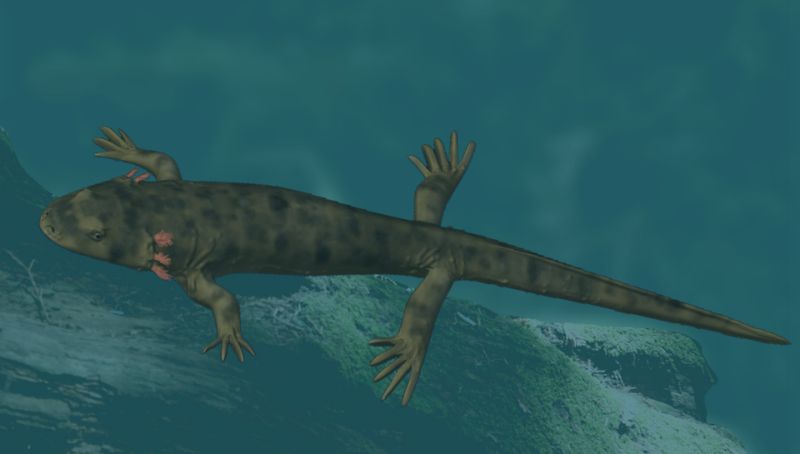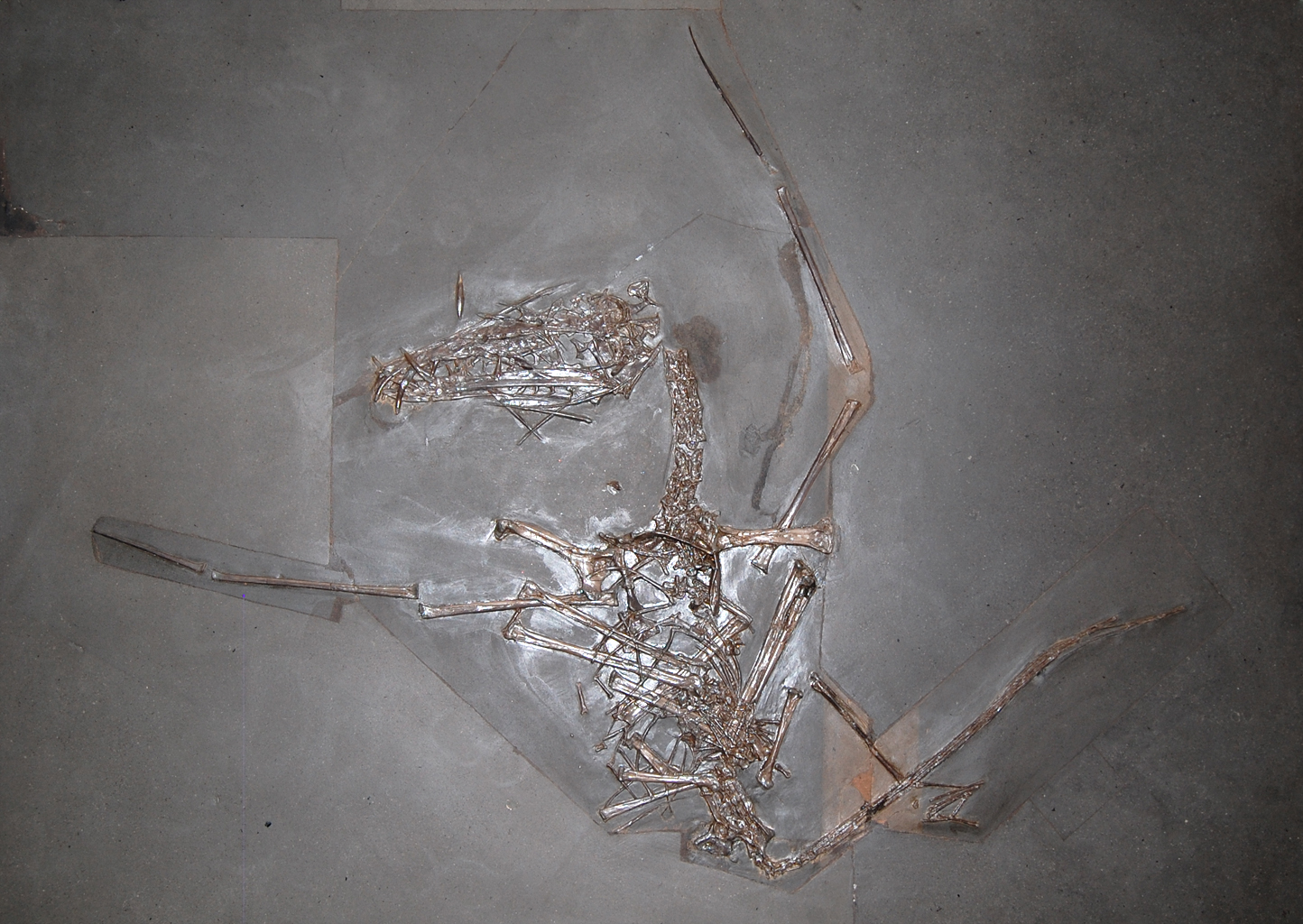|
Changchengopterus
''Changchengopterus'' is a genus of non-pterodactyloid pterosaur from Qinglong County in Hebei Province, China. The fossil specimen, holotype CYGB-0036, of the type and only species, ''Changchengopterus pani'', was found in the Tiaojishan Formation dating from the Callovian and named and described by Lü Junchang in 2009. The generic name combines the ''Changcheng'', the Great Wall of China, with a Latinised Greek ''pteron'', "wing". The specific name honours Pan Lijun, who collected the fossil and donated it to science. The holotype, a skeleton lacking the skull, represents a young juvenile, of which the combined paired wing elements measure just seventeen centimetres.Lü, J. (2009). "A new non-pterodactyloid pterosaur from Qinglong County, Hebei Province of China." ''Acta Geologica Sinica'' (English Edition), 83(2): 189-199. . In 2011, a second specimen was described, PMOL-AP00010, acquired in 2008 by the Paleontological Museum of Liaoning. It consists of a skeleton with lowe ... [...More Info...] [...Related Items...] OR: [Wikipedia] [Google] [Baidu] |
Pterosaur
Pterosaurs (; from Greek ''pteron'' and ''sauros'', meaning "wing lizard") is an extinct clade of flying reptiles in the order, Pterosauria. They existed during most of the Mesozoic: from the Late Triassic to the end of the Cretaceous (228 to 66 million years ago). Pterosaurs are the earliest vertebrates known to have evolved powered flight. Their wings were formed by a membrane of skin, muscle, and other tissues stretching from the ankles to a dramatically lengthened fourth finger. There were two major types of pterosaurs. Basal pterosaurs (also called 'non-pterodactyloid pterosaurs' or 'rhamphorhynchoids') were smaller animals with fully toothed jaws and, typically, long tails. Their wide wing membranes probably included and connected the hind legs. On the ground, they would have had an awkward sprawling posture, but the anatomy of their joints and strong claws would have made them effective climbers, and some may have even lived in trees. Basal pterosaurs were insectiv ... [...More Info...] [...Related Items...] OR: [Wikipedia] [Google] [Baidu] |
Monofenestrata
Monofenestrata is an unranked group of pterosaurs that includes the family Wukongopteridae and the suborder Pterodactyloidea. The clade Monofenestrata was in 2009/2010 defined as the group consisting of ''Pterodactylus'' and all species sharing with ''Pterodactylus'' the synapomorphy of an external nostril confluent with the antorbital fenestra, the major skull opening on the side of the snout. The name is derived from Greek ''monos'', "single", and Latin ''fenestra'', "window". The concept was inspired by the discovery of ''Darwinopterus'', a species combining a pterodactyloid-type skull with a more basal build of the remainder of the body. The Darwinoptera, a primitive subgroup of monofenestratans showing this transitional anatomy, was also named for ''Darwinopterus'' and defined as all descendants of its common ancestor with '' Pterorhynchus''. The earliest known monofenestratan fossils have been found in the Stonesfield Slate formation of the United Kingdom, which dates to t ... [...More Info...] [...Related Items...] OR: [Wikipedia] [Google] [Baidu] |
Timeline Of Pterosaur Research
This timeline of pterosaur research is a chronologically ordered list of important fossil discoveries, controversies of interpretation, and taxonomic revisions of pterosaurs, the famed flying reptiles of the Mesozoic era. Although pterosaurs went extinct millions of years before humans evolved, humans have coexisted with pterosaur fossils for millennia. Before the development of paleontology as a formal science, these remains would have been interpreted through a mythological lens. Myths about thunderbirds told by the Native Americans of the modern Western United States may have been influenced by observations of ''Pteranodon'' fossils. These thunderbirds were said to have warred with water monsters, which agrees well with the co-occurrence of ''Pteranodon'' and the ancient marine reptiles of the seaway over which it flew. The formal study of pterosaurs began in the late 18th century when naturalist Cosimo Alessandro Collini of Mannheim, Germany published a description of ... [...More Info...] [...Related Items...] OR: [Wikipedia] [Google] [Baidu] |
List Of Pterosaur Genera
This list of pterosaurs is a comprehensive listing of all genera that have ever been included in the order Pterosauria, excluding purely vernacular terms. The list includes all commonly accepted genera, but also genera that are now considered invalid, doubtful (''nomen dubium''), or were not formally published (''nomen nudum''), as well as junior synonyms of more established names, and genera that are no longer considered pterosaurian. The list currently includes 263 genera. Scope and terminology There is no official, canonical list of pterosaur genera, but the most thorough attempts can be found at the Pterosauria section of Mikko Haaramo's ''Phylogeny Archive'', the Genus Index at Mike Hanson's ''The Pterosauria'', supplemented by the Pterosaur Species List, and in the fourth supplement of Donald F. Glut's ''Dinosaurs: The Encyclopedia'' series. Authors and year The authors column lists the authors of the formal description responsible for the erection of the genus listed. Th ... [...More Info...] [...Related Items...] OR: [Wikipedia] [Google] [Baidu] |
Tiaojishan Formation
The Tiaojishan Formation is a geological formation in Hebei and Liaoning, People's Republic of China, dating to the middle-late Jurassic period (Bathonian- Oxfordian stages). It is known for its exceptionally preserved fossils, including those of plants, insects and vertebrates. It is made up mainly of pyroclastic rock interspersed with basic volcanic and sedimentary rocks. Previously, the Tiaojishan Formation was grouped together with the underlying Haifanggou Formation (also known as the Jiulongshan Formation) as a single "Lanqi Formation." The Tiaojishan Formation forms a key part of the Yanliao Biota assemblage, alongside the Haifanggou Formation. Age Using Argon–argon dating, Wang and colleagues in 2005 dated part of the Tiaojishan Formation to about 160 million years ago, the beginning of the Oxfordian stage, the first stage of the Upper Jurassic epoch. In 2006, a study by Liu and colleagues used U-Pb zircon dating to conclude that the Tiaojishan Formation correlates wi ... [...More Info...] [...Related Items...] OR: [Wikipedia] [Google] [Baidu] |
Wukongopteridae
Wukongopteridae is a group of basal pterosaurs, found in China and the UK. It contains eight species in five genera, all dated to the Middle to Late Jurassic period, The Wukongopteridae were first named by Wang ''et al.'' in 2009, not yet giving an exact definition.* The clade Wukongopteridae was first defined by Wang ''et al.'' in 2010 as "the most recent common ancestor of '' Wukongopterus lii'' and '' Kunpengopterus sinensis'', and all of its descendants". Description Wukongopterids are characterized by a unique combination of "primitive" and advanced pterosaurian features. While they had long tails and other features characteristic of other "rhamphorhynchoids", they also had distinct pterodactyloid features, such as long vertebrae in the neck and a single skull opening in front of the eyes, the nasoantorbital fenestra (in most "rhamphorhynchoids", the antorbital fenestra and the nasal opening are separate). This feature lead to ''Darwinopterus modularis'' being placed by L ... [...More Info...] [...Related Items...] OR: [Wikipedia] [Google] [Baidu] |
Late Jurassic
The Late Jurassic is the third epoch of the Jurassic Period, and it spans the geologic time from 163.5 ± 1.0 to 145.0 ± 0.8 million years ago (Ma), which is preserved in Upper Jurassic strata.Owen 1987. In European lithostratigraphy, the name "Malm" indicates rocks of Late Jurassic age. In the past, ''Malm'' was also used to indicate the unit of geological time, but this usage is now discouraged to make a clear distinction between lithostratigraphic and geochronologic/chronostratigraphic units. Subdivisions The Late Jurassic is divided into three ages, which correspond with the three (faunal) stages of Upper Jurassic rock: Paleogeography During the Late Jurassic Epoch, Pangaea broke up into two supercontinents, Laurasia to the north, and Gondwana to the south. The result of this break-up was the spawning of the Atlantic Ocean. However, at this time, the Atlantic Ocean was relatively narrow. Life forms of the epoch This epoch is well known for many famous types of dinosau ... [...More Info...] [...Related Items...] OR: [Wikipedia] [Google] [Baidu] |
Europe
Europe is a large peninsula conventionally considered a continent in its own right because of its great physical size and the weight of its history and traditions. Europe is also considered a Continent#Subcontinents, subcontinent of Eurasia and it is located entirely in the Northern Hemisphere and mostly in the Eastern Hemisphere. Comprising the westernmost peninsulas of Eurasia, it shares the continental landmass of Afro-Eurasia with both Africa and Asia. It is bordered by the Arctic Ocean to the north, the Atlantic Ocean to the west, the Mediterranean Sea to the south and Asia to the east. Europe is commonly considered to be Boundaries between the continents of Earth#Asia and Europe, separated from Asia by the drainage divide, watershed of the Ural Mountains, the Ural (river), Ural River, the Caspian Sea, the Greater Caucasus, the Black Sea and the waterways of the Turkish Straits. "Europe" (pp. 68–69); "Asia" (pp. 90–91): "A commonly accepted division between Asia and E ... [...More Info...] [...Related Items...] OR: [Wikipedia] [Google] [Baidu] |
Late Jurassic Pterosaurs Of Asia
Late may refer to: * LATE, an acronym which could stand for: ** Limbic-predominant age-related TDP-43 encephalopathy, a proposed form of dementia ** Local-authority trading enterprise, a New Zealand business law ** Local average treatment effect, a concept in econometrics Music * ''Late'' (album), a 2000 album by The 77s * Late!, a pseudonym used by Dave Grohl on his ''Pocketwatch'' album * Late (rapper), an underground rapper from Wolverhampton * "Late" (song), a song by Blue Angel * "Late", a song by Kanye West from ''Late Registration'' Other * Late (Tonga), an uninhabited volcanic island southwest of Vavau in the kingdom of Tonga * "Late" (''The Handmaid's Tale''), a television episode * LaTe, Oy Laivateollisuus Ab, a defunct shipbuilding company * Late may refer to a person who is Dead See also * * * ''Lates'', a genus of fish in the lates perch family * Later (other) * Tardiness * Tardiness (scheduling) In scheduling, tardiness is a measure of a delay in exe ... [...More Info...] [...Related Items...] OR: [Wikipedia] [Google] [Baidu] |
Rhamphorhynchidae
Rhamphorhynchidae is a group of early pterosaurs named after ''Rhamphorhynchus'', that lived in the Late Jurassic. The family Rhamphorhynchidae was named in 1870 by Harry Govier Seeley.Seeley, H.G. (1870). "The Orithosauria: An Elementary Study of the Bones of Pterodactyles." Cambridge, 135 p. Members of the group possess no more than 11 pairs of teeth in the rostrum, a deltopectoral crest that is constricted at the base but expanded at the distal end, and a bent phalange on the fifth toe. Rhamphorhynchidae traditionally contains two subfamilies: the Rhamphorhynchinae and the Scaphognathinae. While not recovered as distinct clades by all analyses, there do appear to be traits uniting members of each group. Rhamphorhynchines are more common, were lightly built, and had jaws ending in pointed tips that contained more teeth, which are often procumbent (pointed forward). Scaphognathines are comparatively quite rare, were more robust skeletally, and had shorter wing proportions. The b ... [...More Info...] [...Related Items...] OR: [Wikipedia] [Google] [Baidu] |
Dorygnathus
''Dorygnathus'' ("spear jaw") was a genus of Rhamphorhynchidae, rhamphorhynchid pterosaur that lived in Europe during the Early Jurassic period, when shallow seas flooded much of the continent. It had a short () wingspan, and a relatively small triangular sternum, which is where its flight muscles attached. Its skull was long and its eye sockets were the largest Fenestra (anatomy), opening therein. Large curved fangs that "intermeshed" when the jaws closed featured prominently at the front of the snout while smaller, straighter teeth lined the back. Having two or more morphs of teeth, a condition called heterodonty, is rare in modern reptiles but more common in basal ("primitive") pterosaurs. The heterodont dentition in ''Dorygnathus'' is consistent with a piscivore, piscivorous (fish-eating) diet. The fifth digit on the hindlimbs of ''Dorygnathus'' was unusually long and oriented to the side. Its function is not certain, but the toe may have supported a membrane like those support ... [...More Info...] [...Related Items...] OR: [Wikipedia] [Google] [Baidu] |





